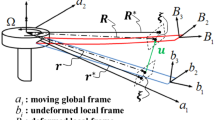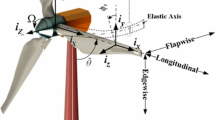Abstract
In this study, the effect of the centrifugal forces on the eigenvalue solution obtained using two different nonlinear finite element formulations is examined. Both formulations can correctly describe arbitrary rigid body displacements and can be used in the large deformation analysis. The first formulation is based on the geometrically exact beam theory, which assumes that the cross section does not deform in its own plane and remains plane after deformation. The second formulation, the absolute nodal coordinate formulation (ANCF), relaxes this assumption and introduces modes that couple the deformation of the cross section and the axial and bending deformations. In the absolute nodal coordinate formulation, four different models are developed; a beam model based on a general continuum mechanics approach, a beam model based on an elastic line approach, a beam model based on an elastic line approach combined with the Hellinger–Reissner principle, and a plate model based on a general continuum mechanics approach. The use of the general continuum mechanics approach leads to a model that includes the ANCF coupled deformation modes. Because of these modes, the continuum mechanics model differs from the models based on the elastic line approach. In both the geometrically exact beam and the absolute nodal coordinate formulations, the centrifugal forces are formulated in terms of the element nodal coordinates. The effect of the centrifugal forces on the flap and lag modes of the rotating beam is examined, and the results obtained using the two formulations are compared for different values of the beam angular velocity. The numerical comparative study presented in this investigation shows that when the effect of some ANCF coupled deformation modes is neglected, the eigenvalue solutions obtained using the geometrically exact beam and the absolute nodal coordinate formulations are in a good agreement. The results also show that as the effect of the centrifugal forces, which tend to increase the beam stiffness, increases, the effect of the ANCF coupled deformation modes on the computed eigenvalues becomes less significant. It is shown in this paper that when the effect of the Poisson ration is neglected, the eigenvalue solution obtained using the absolute nodal coordinate formulation based on a general continuum mechanics approach is in a good agreement with the solution obtained using the geometrically exact beam model.
Similar content being viewed by others
References
Bauchau, O.A.: Computational schemes for flexible nonlinear multibody systems. Multibody Syst. Dyn. 2, 169–225 (1998)
Bauchau, O.A., Bottasso, C.L., Nikishkov, Y.G.: Modeling rotorcraft dynamics with finite element multibody procedures. J. Math. Comput. Modeling 33, 1113–1137 (2001)
Berzeri, M., Shabana, A.A.: Study of the centrifugal stiffening effect using the finite element absolute nodal coordinate formulation. Multibody Syst. Dyn. 7, 357–387 (2002)
Cesnik, C.E.S., Hodges, D.H., Sutyrin, V.G.: Cross-sectional analysis of composite beams including large initial twist and curvature effects. AIAA J. 34, 1913–1920 (1996)
Crisfield, M.A.: Non-Linear Finite Element Analysis of Solids and Structures, vol. I: Essentials. Wiley, New York (1997)
Garcia-Vallejo, D., Sugiyama, H., Shabana, A.A.: Finite element analysis of the geometric stiffening effect, part 1: a correction in the floating frame of reference formulation. IMechE J. Multibody Dyn. 219, 187–202 (2004)
Garcia-Vallejo, D., Sugiyama, H., Shabana, A.A.: Finite element analysis of the geometric stiffening effect, part 2: non-linear elasticity. IMechE J. Multibody Dyn. 219, 203–211 (2004)
Hodges, D.H.: A review of composite rotor blade modeling. AIAA J. 28, 561–565 (1990)
Hussein, B., Sugiyama, H., Shabana, A.A.: Coupled deformation modes in the large deformation finite element analysis: problem definition. ASME J. Comput. Nonlinear Dyn. 2, 146–154 (2007)
Johnson, W.: Helicopter Theory. Princeton University Press, New Jersey (1980)
Mikkola, A.M., Shabana, A.A.: A non-incremental procedure for the analysis of large deformation of plates and shells in mechanical systems application. Multibody Syst. Dyn. 9, 283–309 (2003)
Pascal, M.: Some open problems in dynamic analysis of flexible multibody systems. Multibody Syst. Dyn. 5, 315–334 (2001)
Reissner, E.: On a variational theorem for finite elastic deformation. J. Math. Phys. 32, 129–135 (1953)
Schilhans, M.J.: Bending frequency of a rotating cantilever beam. Trans. ASME J. Appl. Mech. 25, 28–30 (1958)
Schwab, A.L., Meijard, J.P.: Comparison of three-dimensional flexible beam elements for dynamic analysis: finite element method and absolute nodal coordinate formulation. In: Proceedings of ASME International Design Engineering Technical Conferences and Computer Information in Engineering Conference (DETC2005/ MSNDC-85104), Long Beach, CA, USA (2005)
Shabana, A.A.: Dynamics of Multibody Systems, 3rd edn. Cambridge University Press, Cambridge (2005)
Shabana, A.A., Yakoub, R.Y.: Three dimensional absolute nodal coordinate formulation for beam elements: Theory. ASME J. Mech. Des. 123, 606–613 (2001)
Wallrapp, O., Schwertassek, R.: Representation of geometric stiffening in multibody system simulation. Int. J. Numer. Methods Eng. 32, 1833–1850 (1991)
Wu, S.C., Haug, E.J.: Geometric non-linear substructuring for dynamics of flexible mechanical systems. J. Numerical Methods Eng. 26, 2211–2226 (1988)
Yakoub, R.Y., Shabana, A.A.: Three-dimensional absolute nodal coordinate formulation for beam elements: implementation and applications. ASME J. Mech. Des. 123, 614–621 (2001)
Author information
Authors and Affiliations
Corresponding author
Rights and permissions
About this article
Cite this article
Maqueda, L.G., Bauchau, O.A. & Shabana, A.A. Effect of the centrifugal forces on the finite element eigenvalue solution of a rotating blade: a comparative study. Multibody Syst Dyn 19, 281–302 (2008). https://doi.org/10.1007/s11044-007-9070-6
Received:
Accepted:
Published:
Issue Date:
DOI: https://doi.org/10.1007/s11044-007-9070-6




